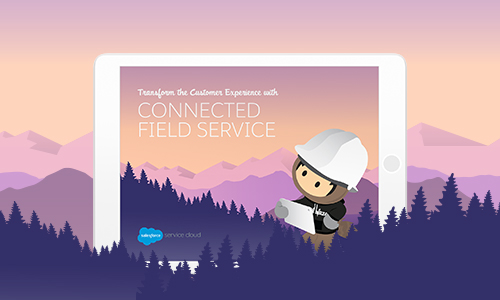The first-time fix can be a very powerful customer experience. But for many field service agents, nailing that initial visit is harder than ever.
Complex logistics, rising customer expectations, poor inventory planning, not to mention tired, paper-based processes. Challenges abound – and they aren’t native to just one industry, either. Wherever you look – from healthcare to finance and manufacturing – you’ll find field service teams in need of a helping hand.
In a world of disconnected mobile agents, and customers whose loyalty is swayed by the service they receive, this has to change. At Salesforce World Tour 2018, we heard from two Trailblazers to discover how they use Salesforce tools to bridge the divide between the connected customer and their mobile workforce.

Daikin Applied: A 12-week customer service transformation
Headquartered in Osaka, Japan with operations across 75 countries, the air conditioning manufacturer needed help to drive lifecycle revenue, lock down opportunities and better connect its service teams to its customers.
CRM Manager John McCarthy spoke about the transformational journey Daikin Applied embarked on with the help of Salesforce – especially Field Service Lightning, which is helping the company to do three key things:
1. Connect the business
With everyone connected on one platform, Daikin Applied can now share information about every customer across the entire business. Thanks to this single view, Daikin’s teams are fully collaborative, enabling them to easily generate work orders, fulfil service contracts and maintenance agreements, and share updates through Chatter.
2. Optimise the workforce
Field Service Lightning is powered by intelligent scheduling, allowing Daikin Applied to schedule and manage every job from a single platform with full visibility of each agent’s movements in the field. This enables the scheduling team to optimise resource schedules, assign work based on role and location, and maximise first-time fixes by ensuring each job gets the right agent with the right inventory.
3. Engage on mobile
With Salesforce’s offline mobile capabilities, Daikin employees can access and update information even when they’re not connected. And with real-time inventory management, agents can scan equipment barcodes and generate service reports on site before capturing the customer’s signature digitally, there and then.
After a super-fast, 12-week transformation, Daikin Applied is using Field Service Lightning to measure key metrics across the business, including first time fix-rates, how well the company adheres to service-level agreements, and, most importantly, customer feedback.
Daikin Applied is also now making extensive use of Service Cloud, Sales Cloud, and CPQ. Over the next 18-20 months, John believes these tools will continue to drive a transformation that’s already being felt today:
“We’re seeing drive towards high profile processes with tight margins, more optimized resource management, and customer feedback from every technician appointment. It’s this powerful and insightful reporting that will help us make more informed decisions to grow the business. It’s very exciting.”
When asked if he would have done anything differently in the lead-up to this transformation, John had an encouraging message for those in similar shoes:
“I wasn’t a Salesforce expert at the start. I’d take the time to learn more about Salesforce and ensure executive engagement from the start – once they’re comfortable, you can move forward and start building teams who will help you blaze a trail.”
You can watch the highlights from John's session: Transform Custoemr Service from the Phone to the Field below
KONE: Elevating service with Field Service and AI
A Salesforce customer since 2006, KONE has since made incredible strides in field service management. The Finnish engineering and service company services over 450,000 customers around the world, and more than 1 billion people ride their escalators, elevators, and moving walkways every single day.
Having long championed their innovation in human mobility and customer journeys, during World Tour London we invited KONE to give a live demonstration of a typical day in their field service operation.
With Field Service Lightning open on screen, we saw a scenario where an engineer is stuck in traffic on the way to the customer. Thanks to the platform’s intelligent scheduling capabilities, an alert is flagged to the dispatching team, containing everything they need to know about the situation.
While the app can automate job reassignment in such a scenario, KONE chooses to observe its other engineers manually to gauge who is best suited to the job. With a complete view of each engineer and customer, including their service history and use capability, a suitably close replacement with the right tools is assigned. Problem solved.
Later in the demo, we saw how Field Service Lightning can be used remotely to ensure the safety of KONE’s technicians. In this scenario, a proactive alert allows the technician to deactivate a faulty elevator from the app to avoid any nasty surprises.
From here, she uses augmented reality (powered by Einstein Vision) to get the data she needs to perform the repair safely and efficiently. No catalogue codes, paperwork, or backup required. And should she need it, the AR display is able to recommend informative articles and problem-solving tips to help her get to the root of the problem, fast.
Before heading to her next job, she uses Field Service Lightning to update the inventory and indicate the parts used. Back at the warehouse, this is also visible, allowing them to reorder any parts that may be running low. All that’s left to do is get the work order signed by the customer and close the case. Simple.
Best Practices for Transforming the Customer Experience with Field Service
Field service teams are facing whole new challenges to meet the needs and expectations of today’s connected customers. Download this e-book to see how your business can revolutionise the way you manage service to deliver a faster, smarter, more personalised customer experience from end-to-end.








